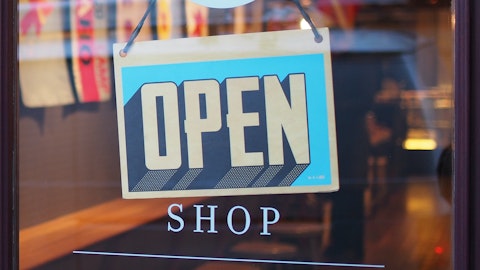Mark Carden: All right. Great. Thanks so much. Good luck, guys.
Eric van der Valk: Thanks Mark.
John Swygert: Thanks Mark
Operator: Thank you. One moment for our next question. And our next question comes from the line of Kate McShane from Goldman Sachs. Your question, please.
Kate McShane: Hi. Good morning. Just a quick question from us back to the sales growth during the quarter. Just we know primarily, it was driven by transactions, as you mentioned, but can you talk to ticket during the quarter and how you see that playing out for the back half of the year?
Rob Helm: Hi Kate, this is Rob. Transactions primarily drove it. It was probably about 85% of the comp. The remainder of the comp was basket, which was up low singles.
Kate McShane: Thank you.
Operator: Thank you. One moment for our next question. And our next question comes from the line of Simeon Gutman from Morgan Stanley. Your question, please.
Simeon Gutman: Hi, good morning, guys. First, a quick follow-up on shrink. Can you tell us what the timing of your physical inventories? How quickly or how often or frequently are you doing them? And I think to summarize what you said, it got a little bit better than what you were run rating prior to this quarter?
Rob Helm: Sure. This is Rob. We count our store fleet throughout the course of the year. So we’re about halfway through the year. We’ve counted about half of the stores. From a shrink perspective, we are slightly better, not significant enough to call out as an impact within our gross margin for the second quarter.
Simeon Gutman: Okay. And a quick follow-up, back on the sales strength. Given that traffic is strong, it seems like the consumer is moving towards value, and I think we’ve seen that. Curious how you kind of weight the strong performance between the merchandising and the success of the closeout merchandise against that customer seeking maybe the channel and value a little bit more?
Rob Helm: Yes. I think, Simeon, that’s hard to bifurcate what that is. But I would tell you, the deals drive the customers to respond and the value we offer to the customer. So right now, they’re looking for the deals – we have some great deals and great brands in our stores and they’re responding to what we’re giving. As you can tell with our top five categories, it’s not all consumable. There’s some – a lot of discretionary there with summer furniture, lawn and garden coming through. So they’re responding to what we’re able to show them what the great values were given to them. So that’s number one key regardless of what’s going on in the marketplace.
Simeon Gutman: Yes, okay. Nice quarter. Good luck.
Rob Helm: Thank you.
Operator: Thank you. One moment for our next question. And our next question comes from the line of Paul Lejuez from Citi. Your question, please.
Paul Lejuez: Hi, thanks guys. Curious if you could talk a little bit more about the better gross margin rate in the second quarter? How much was from lower supply chain costs versus merchandise margin improvement? And within that merchandise margin improvement, how much was driven by better buying or initial markup versus just having lower promotions? And then second, on the store opening plans for F ’24, how many stores do you already have locked and loaded for next year? Thanks.
Rob Helm: Thanks, Paul, this is Rob. From a gross margin perspective, out of the 650 basis points of expansion, supply chain was roughly 550 basis points. Merchandise margin was about 100 basis points, net of the impact of shrink. The lion’s share of that improvement was improved deal flow and better IMU on our buys versus the reduced promotions.
Paul Lejuez: [indiscernible] stores?
Rob Helm: Yes. We wouldn’t answer that question. It’s maybe a little too detailed. We’re not speaking to 2024 guidance. So I indicated that 50 stores is realistic for 2024. And so that’s —
John Swygert: We’ll give you more on the future calls with regards to – obviously, we do – we take second-generation sites, so we’re not building. So our lead time is a lot less. But we don’t want to give any 2024 guide right now. I think the reality is around 50 stores for next year.
Paul Lejuez: Got it. Thanks. Good luck.
Rob Helm: Thank you.
Operator: Thank you. This does conclude the question-and-answer session of today’s program. I’d like to hand the program back to John Swygert for any further remarks.
John Swygert: I would like to thank everyone for their time and interest in Ollie’s. We feel very good about our positioning in the back half of the year and look forward to updating you on our continued progress on our next earnings call. Thank you.
Operator: Thank you, ladies and gentlemen, for your participation in today’s conference. This does conclude the program. You may now disconnect. Good day.
Follow Ollie's Bargain Outlet Holdings Inc. (NASDAQ:OLLI)
Follow Ollie's Bargain Outlet Holdings Inc. (NASDAQ:OLLI)
Receive real-time insider trading and news alerts




